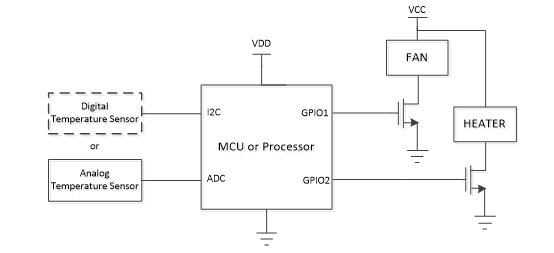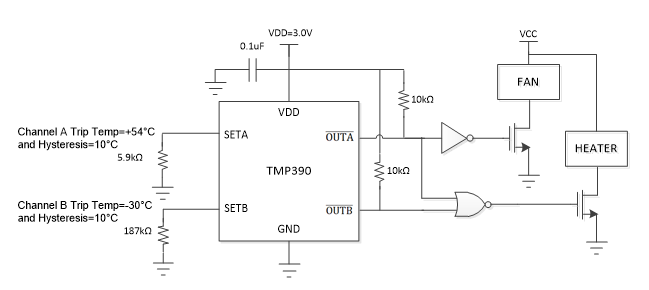SSZT351 january 2020 TMP390

Because of their role in security applications, it’s important that outdoor cameras do not malfunction or fail, regardless of whether they’re placed in tropical or frigid climates, or climates that experience both extremes in a given day.
Older generations of outdoor cameras can only operate reliably within a specific temperature range. When the temperature is low, a lithium battery’s capacity degenerates rapidly because of its bigger internal resistor and may even fail. When the temperature is high, the camera’s image sensor may produce “hot pixels,” which are bright individual pixels that adversely affect the overall picture quality.
Designing an outdoor camera that can endure environmental temperatures in a wide temperature range – from -30°C to +55°C – comes with two key design challenges, however. The first challenge is the ability to start up when temperatures are extremely low or high. The second challenge is the need to measure temperatures accurately within a wide temperature range, since the operation of a fan or heater installed inside the camera is based on temperature measurements. Accurate temperature results can maximize a camera’s operational temperature range and prevent device failure.
A design with a temperature switch can help resolve both of these challenges.
| Learn more about the TMP390 temperature switch | |

|
Driving industrial innovation with small-size sensors |
How fans and heaters enable efficient operation
 Figure 1 A traditional temperature protection design
Figure 1 A traditional temperature protection designThe TMP390 dual-channel temperature switch offers independent over- and under temperature detection without using a MCU. Because the temperature switch controls the fan and heater directly, it can provide proper temperature for the whole system before MCU startup, thus preventing the MCU from operating in extreme high or low temperatures. Resistor-programmable temperature trip points offer flexibility for a variety of applications, while resistor-programmed thermal hysteresis options of 5°C or 10°C prevent undesired digital output switching.
During a startup process (see Figure 2) in extremely low temperatures, after the power turns on, the temperature switch starts up first; the MCU or other components remain off. As the temperature moves out of the safety range, is active low, while the heater and fan start to increase the internal temperature. When the temperature gets to a pre-selected value, the whole system begins the startup process. Compared to the traditional design for temperature protection in Figure 1, the TMP390 temperature switch can regulate the temperature before system startup, thus meeting the challenge to enable startup in extremely low or high temperatures.
 Figure 2 The TMP390 example circuit at +60°C and -40°C thresholds with 10°C hysteresis
Figure 2 The TMP390 example circuit at +60°C and -40°C thresholds with 10°C hysteresisThe TMP390 temperature switch has 3C accuracy from -55°C to +130°C (±1.5°C from 0°C to +70°C), which provides enough accuracy for a wide temperature range. With accurate temperature measurement, an outdoor camera doesn’t have to leave additional margin for temperature protection, which maximizes the operational temperature range and protects the devices within the system efficiently. Since the TMP390 temperature switch can control the fan or heater accurately, it’s possible to save excessive power in your outdoor camera designs.